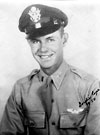Base jets help bring flyer home
By Turner Walston
Published in News on June 6, 2005 1:49 PM
A Texas family said goodbye to a missing hero Tuesday after more than 50 years of waiting to bring him home.
Capt. Troy G. "Gordie" Cope was flying an F-86 Sabrejet when he was shot down over China by a Russian pilot on Sept. 16, 1952. During the Korean War, the 28-year-old Cope was a pilot with the 335th Fighter Squadron, now based out of Seymour Johnson Air Force Base and known as the Chiefs.

Cope
Cope and his wingman faced three waves of three MiG (Soviet aircraft) fighter jets before Cope was shot down. Notorious for its dogfights, the area above China was known as "MiG alley." In Sept. 1952, there were 706 aerial engagements.
Cope's jet crashed just across the North Korea border in China. That day, he was listed as Missing in Action. His status was changed to Killed in Action in Dec. 1953. For more than 40 years, the military had no record of Cope's disappearance. "There were still a lot of questions out there," said Lt. Col. Pat Doherty, operations officer with the 335th Chiefs.
In 1995, American businessman Warren Sessler was living and working in east China. He was touring the Museum to Commemorate Aiding Korea against U.S. Aggression in Dandong, China. Sessler noticed three sets of American dogtags on display at the museum.
"He asked the museum curator, 'Hey, can I get a rubbing of these dog tags?' and that's how the whole research came about," Doherty said.
Sessler then turned the rub over to the U.S. Embassy in China.
Over the next several years, through cooperation with the Chinese and Russian governments, officials were able to determine where it was believed Cope's plane had crashed.
Members of Cope's family went to Washington, D.C. to be a part of the Korean War Family update. There, they learned that representatives of the U.S. government had gone to Dandong as part of a preliminary investigation. Evidence of aircraft, pieces of flight suit, and other items that warranted excavation at the site had been found, said Capt. Cope's nephew, Chris Cope.
Chris Cope was part of the team that went to the crash site last summer to recover the remains. He arrived on May 31.
"I spent two weeks in China being a part of that recovery operation," Chris said. He said he had a feeling his uncle's remains had been found. Months later, his hopes were confirmed. The aircraft and remains were repatriated.
"We got a positive I.D. in October, so we decided to have a memorial weekend event for his funeral service and burial," Chris said.
On May 31, the city of Plano, Texas, celebrated 'Captain Troy Gordon Cope Day.' The family held a funeral service, and members of the 335th Fighter Squadron conducted a flyover in the four-ship Missing Man formation, a military tradition to honor fallen airmen.
"Almost 53 years later, no one's given up on Capt. Cope," said Col. Todd Boyd, commander of the 335th, who led the missing-man formation. "He was a member of the 335th when he got shot down. It's an honor to us to honor one of our fallen.
"To be able to lead this formation and bring honor to his family, it's pretty emotional for the guys flying in it. The fact that he's one of our fellow Chiefs is a big deal."
Doherty said the Cope case helped the military find out exactly who they were fighting in the Korean conflict. "We thought we were probably flying against some Chinese fighter pilots with a lot of Russian technology assistance, material assistance, and technical advisory assistance," he said. "Come to find out, no kidding, Russian top pilots were flying for North Korea. So we were dogfighting with USSR pilots. It was suspected, but there was no evidence."
Chris Cope has written two letters to the museum in Dandong asking for Capt. Cope's dog tags to be returned to the family. "According to international law, they don't have to. It's considered war booty," Chris said.
Regardless, the funeral and flyover will go on as planned. The funeral home, a Dignity Memorial provider, is donating its services, while the U.S. government has provided the casket.
A veteran of World War II as well as the Korean War, Capt. Cope will be buried with the Purple Heart, Air medal, Good Conduct medal, American Campaign medal, Asiatic-Pacific Campaign medal with one bronze service star, World War II Victory medal, National Defense Service medal, Korean service medal with three bronze service stars, Republic of Korea Presidential Unit Citation, United Nations Service medal, and World War II Honorable Service lapel pin.
"We never thought we'd ever see this day happen," Chris said. "We had a memorial service in 1988. We never thought we'd know anything more. Here, 17 years later, we're bringing him back."
The service was a tribute to families of MIA military members as well as Capt. Cope. "You just don't know the feelings of being a family member of a missing serviceman until you go through the experience," Chris Cope said before the service.
Chris and the airmen both said the case was a reminder that the government does not give up on its fallen military.
"As an airman flying in combat, it makes us feel better," Boyd said. "The military and our government's not going to give up on us. As a combat flyer, that's something that gives us strength and confidence when we go out and fly."
"That's just a testament to 'You Will Not Be Forgotten,'" Cope said. "That's part of the POW-MIA emblem: You Will Not Be Forgotten."
Doherty said the Cope repatriation would be a history lesson for his pilots. "These lieutenants now can connect the dots -- this lineage of warriors."
"He's one of our guys," Doherty said of Cope. "He's a Chief."
